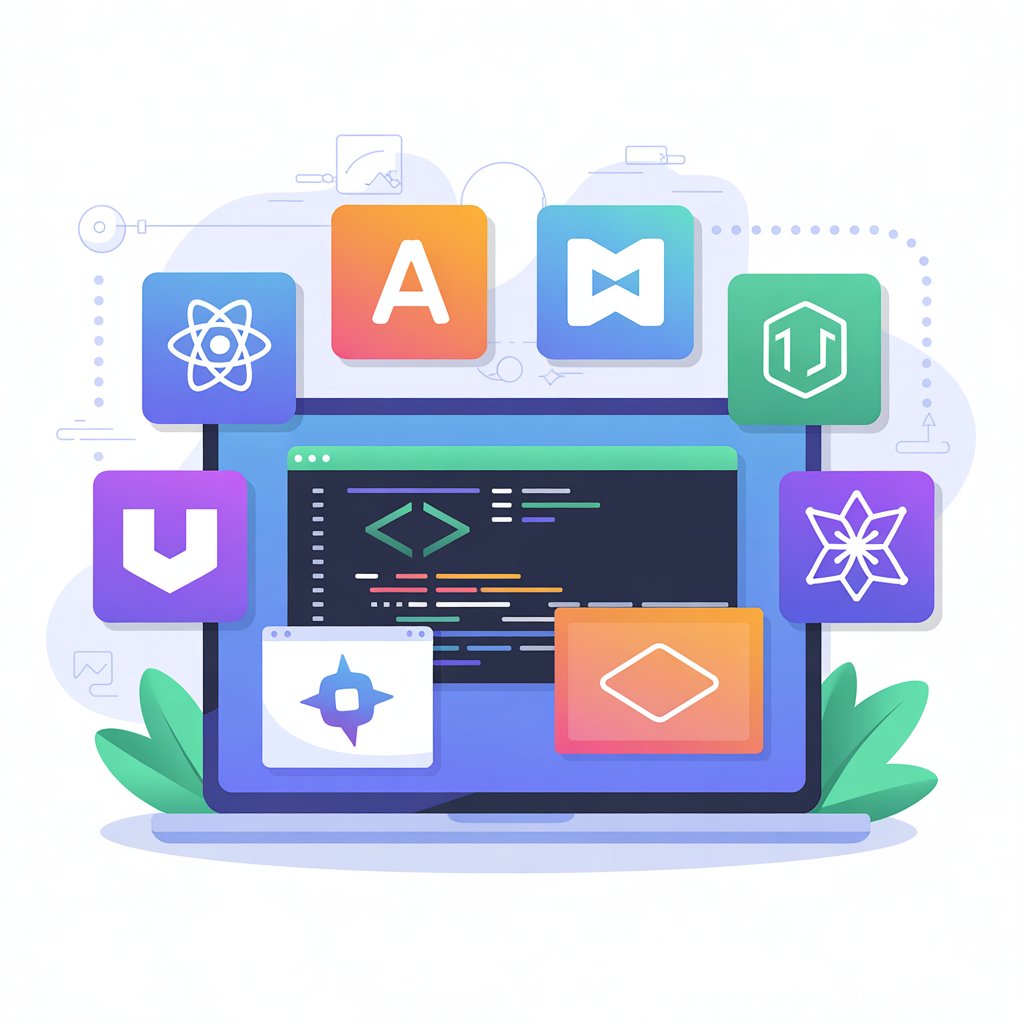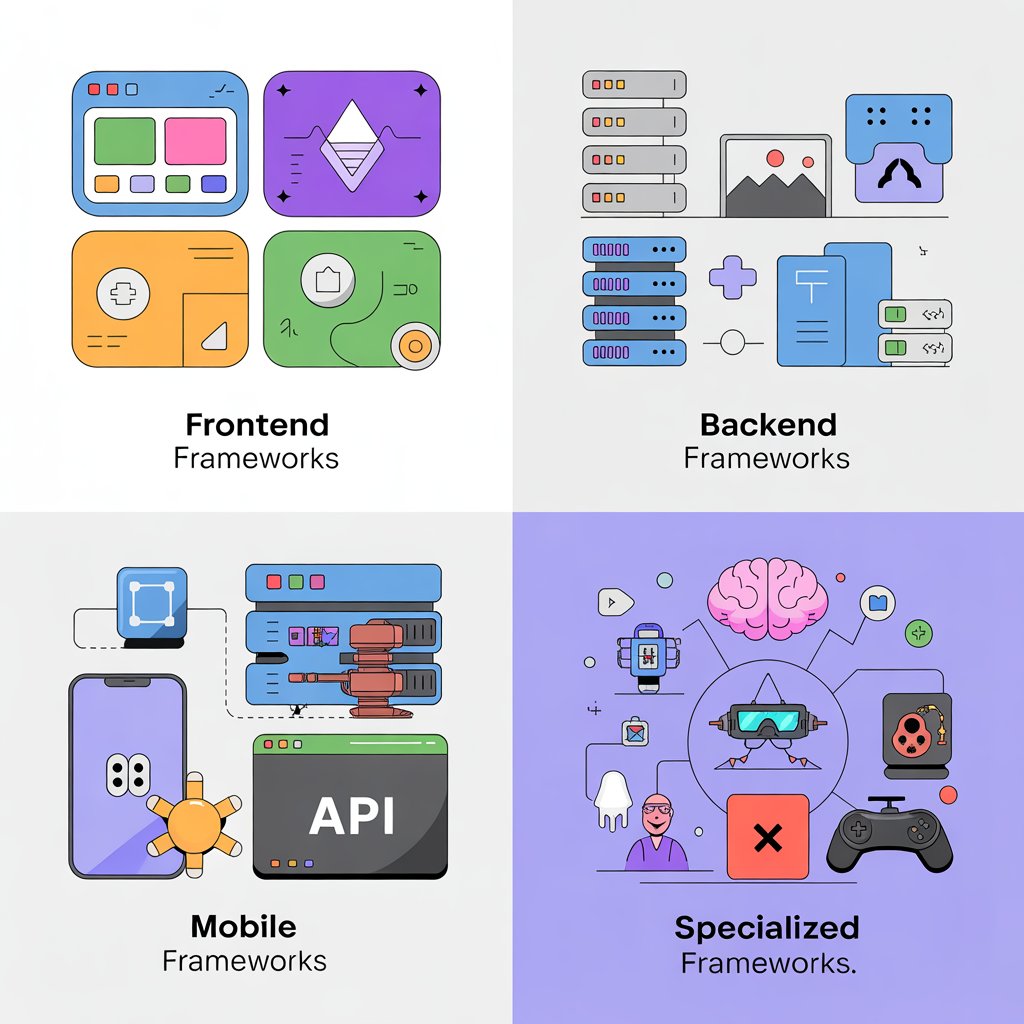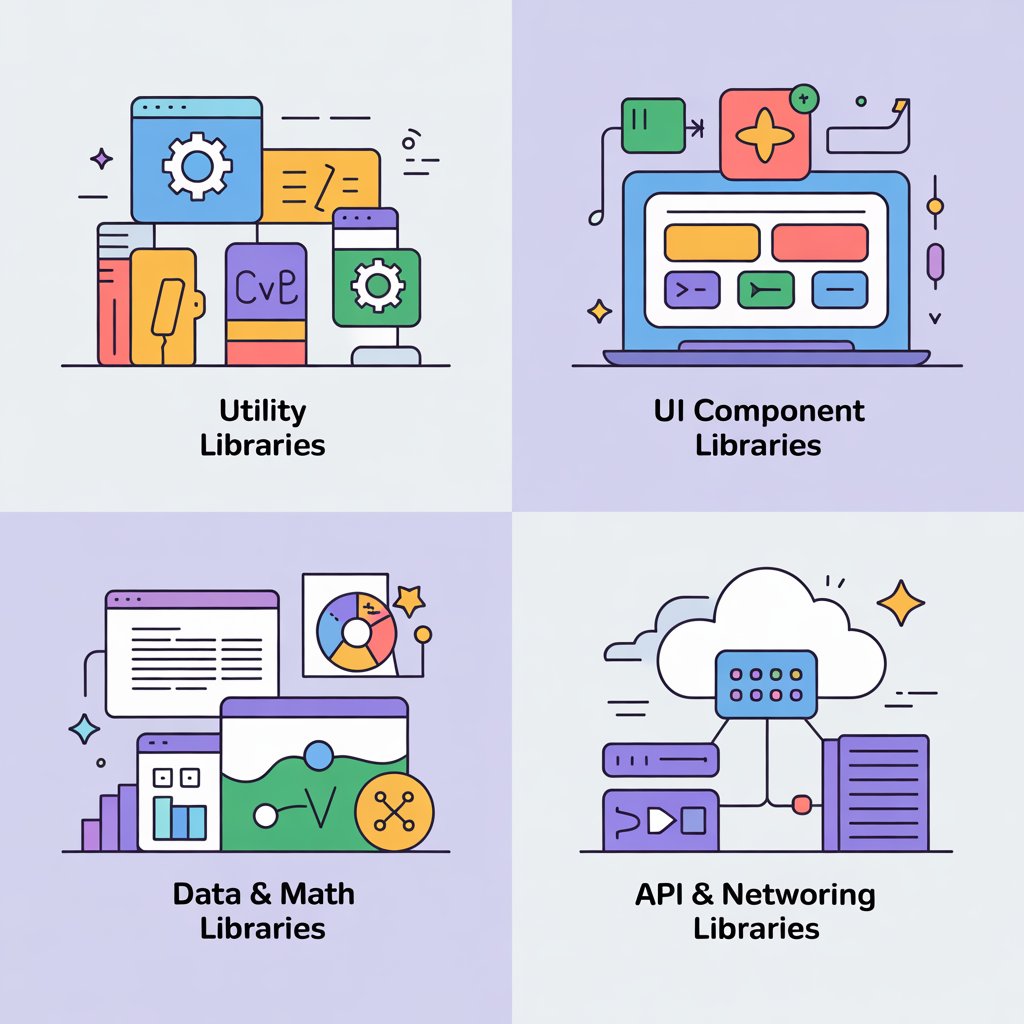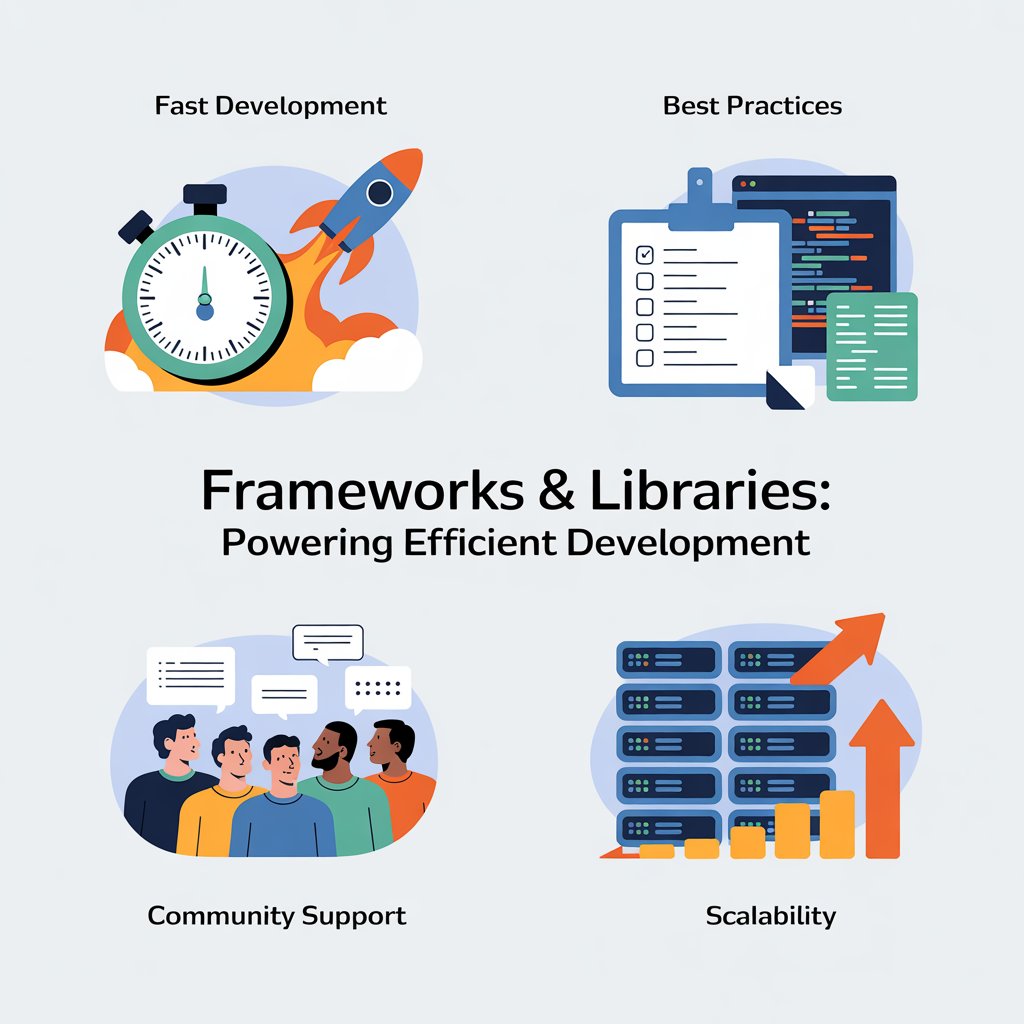Frameworks & Libraries


The use of libraries and frameworks is no longer a choice in the current software development world. They are useful while developing a small project or an extensive enterprise since they simplify the development process and provide assurance that there is quality software.
It is important to understand the terms “framework” and “library” since, although used interchangeably, they are different and each has a particular application in software development. One is an entity in software and the other is a set of software entities.
What are Frameworks and Libraries?
Frameworks are specific to projects. They provide a skeleton and they control the application flow as well as enforcing some coding standard rules like organizational structure and design patterns of the project. “Code runs on the framework”, as frameworks provide some structure and guidelines.
Libraries are project independent. These are sets of codes that are created to help the process of coding. Libraries simplify coding, ease, and while a coder may use libraries of code to complete something, the coder has the option of the structure of an application. Libraries have to be invoked to perform particular purposes.
Types of Frameworks…

Frontend Frameworks
Purpose:
Frontend frameworks allow developers to create dynamic and interactive user interface for web applications. They manage the UI state, update the Document object mode efficiently, and manage user interactions.
Features:
- Component base architecture
- Data binding
- Routing
- State management
Example:
- Angular: A feature-rich framework with steep learning curve, best suited for SPAs at enterprise level.
- Vue js: Light, adaptable and easy to fit into existing projects.
- Svelte: compiles code at build time, outputs highly optimized, stripped javasctipt for high performance
- Admin dashboards, e-commerce site, single page application.
Backend Frameworks
Purpose:
Backend frameworks manage server side logic, database access, APIs, authentication and app security. They offer a framework to build solid, scalable web services.
Features:
- Routing and middleware handling
- Database ORM integration
- Support for authentication and authorization
- Inbuilt tools for security and error handling
Example:
- Django: Complete framework that includes ORM, authentication and admin panel.
- Express.js: Lightweight and simple framework to implement RESTful APIs and server-side applications.
- Spring Boot: Power-packed framework designed for microservices architecture.
Use Cases:
RESTFUL APIs, e commerce backends, enterprise web applications, microservices architecture.
Mobile Framework
Purpose:
A cross-platform framework that helps to developers to develop applications for all platforms, including Android, iOS, and possibly the web, with a single code base, saving time and cost.
Features:
- Hot reload
- Access to device APIs
- UI libraries to provide uniform look on all platforms
Examples:
- Flutter: Uses dart and has a strong widget system for a stunning native like UI
- React Native: Uses javascript/React and offers integration of native code for added functionality
- Lonic: Uses web technologies to build hybrid apps with native containers wrapping around
Use Cases:
Startups developing apps for Android and IOS, MVPs, hybrid apps for internal business tools.
Specialized Frameworks
Purpose:
The frameworks target specific areas of development, such as AI, game development, or server-side rendering for web applications. They offer tools for specific tasks rather than general app development.
Features:
- Highly optimized for their area
- Several have built-in models, engines or renderers
- Commonly used in combination with other frameworks or libraries to build full applications.
Examples:
- TensorFlow: A machine learning framework for the construction, training, and deployment of neural networks.
- Unity: Game engine/framework for creating 2D, 3D, AR and VR games and simulations.
- Next.js: Server side rendering, static site generation and building SEO optimized web applications using React.
Use Cases:
AI/ML applications, 3D/AR/VR game development, content heavy sites with server side rendering.
Type of Libraries…

Utility Libraries
Purpose:
Utility libraries contain reusable helper functions that simplify common programming tasks. They are developer time savers since they offer already developed functions for different data manipulation, string formatting, deep cloning and other common operations.
Features:
- Simplify repetitive tasks like array manipulation, object merging and string operations.
- Decrease the need to build a custom utility function from scratch.
- Increase code readability and maintainability.
Example:
- Lodash: Provides functions like map, .filter, .cloneDeep, for handling arrys, objects, and collections.
- Requests: Makes it easier to handle HTTP requests manage responses and handle headers or sessions.
Use Cases:
Web applications needing data transformations, APIs, or utility heavy operations scripts and automation tasks.
UI Component Libraries
Purpose:
UI component libraries provide pre designed, styled elements such as buttons, modals, forms, and navigation bars. This helps developers quickly create professional looking user interfaces.
Key features:
- Pre-built design elements that implement best practices
- Design consistency throughout the application
- Typically includes themes and accessibility support
Example:
- Material UI: React components based on Googles Material design specifications.
- Bootstrap: CSS framework with common components and a grid system for responsive design.
- Chakra UI: Reachable and highly customizable React component library with a modular design.
Use cases:
Quick frontend development, prototyping, company web applications, dashboards, or ecommerce web sites.
Data & Math Libraries
Purpose:
The libraries are applied for mathematical calculations, statistical computation, and data visualization, offering unique capabilities that eliminate much of the complexity of calculations.
Features:
- Handle numerical computation and arrays very efficiently.
- Data handling, data aggregation and statistical computation.
- Have the ability to visualize data through plots/charts/graphs.
Examples:
- Numpy : For numerical arrays, linear algebra and advanced maths functions.
- Pandas : Data structures to manage and process structured data in a efficient manner such as dataframes.
- D3.js : A very powerful library for the generation of dynamic and interactive data visualizations on the web.
Use Cases:
scientific computing, ML, finance analysis, dashboards, and reporting tools.
API & Networking Libraries
Purpose:
The networking libraries and APIs provide developers classes to make information get from and information submit to remote to remote servers via HTTP requests as well as how to handle RESTfull APIs overall. They simplify the communication between server and client.
Features:
- Make HTTP requests simple
- Deal with components of an HTTP request
- Are inclined to have functions for asynchronous requests and error handling
Examples:
- Axios: A promise-based HTTP client to send requests from web applications through APIs.
- Retrofit: Type-safe HTTP client for mobile and Java-developed applications.
Use Cases:
To create mobile or web applications consuming third party APIs, retrieve or send data
To a server, and to build RESTful or GraphQL endpoints.
Advantages of using frameworks and libraries…
Fast development frameworks and libraries allow developers to utilize pre-built functions, tools and components to reduce effort and time. Instead of carrying out all the effort in order to develop features such as from validation, however developers can just utilize the built in solutions. Besides they eliminate duplicate code making the delivery time faster.
Prescribed best practices most frameworks enforce industry trends usually MVC or MVVM and hence have an expected code structuring. Organizations can work together across codebases without worrying about how differing coding standards breed cryptic bugs that are hard to service. For example, spring boot operations include modular building and dependency injection support build scalable systems.
Community support Most popular tools have a massive following community providing access to many tutorials, forums, patches and plugins. React has zillions of open source libraries and a super active developer community. When bugs are found, they can be fixed very quickly also and new features come faster to accelerate.
Better scalability frameworks are architecture integrated and fully featured. Caching, ORM, and module apps are features included in most frameworks to aid in scaling. Libraries also scale systems through reuse of optimized code so that projects thrive without another full rewrite.

Challenges and Risks of using frameworks and Libraries…
Learning curve
Most frameworks are complicated and involve a lot of learning time for instance, learning spring boot or angular involves learning different parts that contribute to early slowing for new learners.
Performance overhead
Frameworks do have features you will never use, which simply add weight and cause bottlenecks. Most projects are not worth the use of a heavyweight framework.
The risk of Dependencies
Use of dependencies, always third party code, can be dangerous. Framed libraries may become outdated or completely obsolete, or introduce vulnerabilities which could compromise your project.
Lock in
It can be very costly in terms of time and processes to replace a framework on the fly when you’ve already committed to using it. Each framework will place you into its own architecture and pattern enforcements.
Framework and library trends(2025)…
- Full stack frameworks like Next.js and Nuxt gaining popularity.
- Micro frameworks for performance focused apps
- Cross platform development with Flutter and React Native dominating mobile.
- Utility-first style libraries like Tailwind CSS replacing traditional CSS frameworks
- AI-powered libraries beginning to be present for code generation, testing and optimization.
Best practices to select frameworks and libraries…
Always employ a framework or library based on what your project requires. Lightweight is optimal for small programs but organized framework like Django or Spring Boot is optimal for big projects.
Documentation and community size are significant too. Good documentation eases the process of adoption and lowers the learning curve, and a healthy community offers quick fixes and pooled expertise.
It’s also smart to keep an eye on long term maintainability. While broad usage and well updated tools are more stable, old ones will eventually be expensive to transition.
Finally, stay away from superfluous dependencies in the short term more libraries could speed things up, but they can also cause bloat, security threats and future maintenance issues
